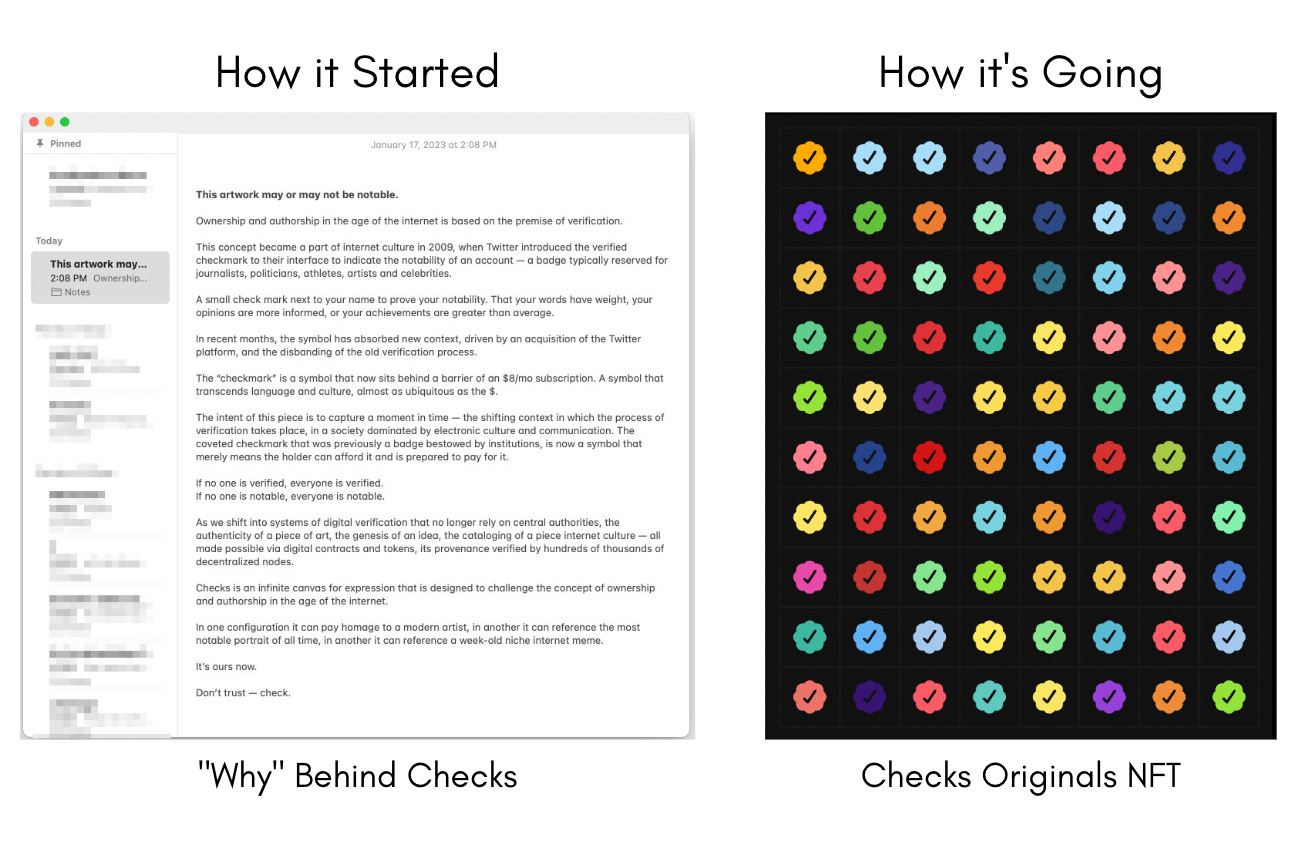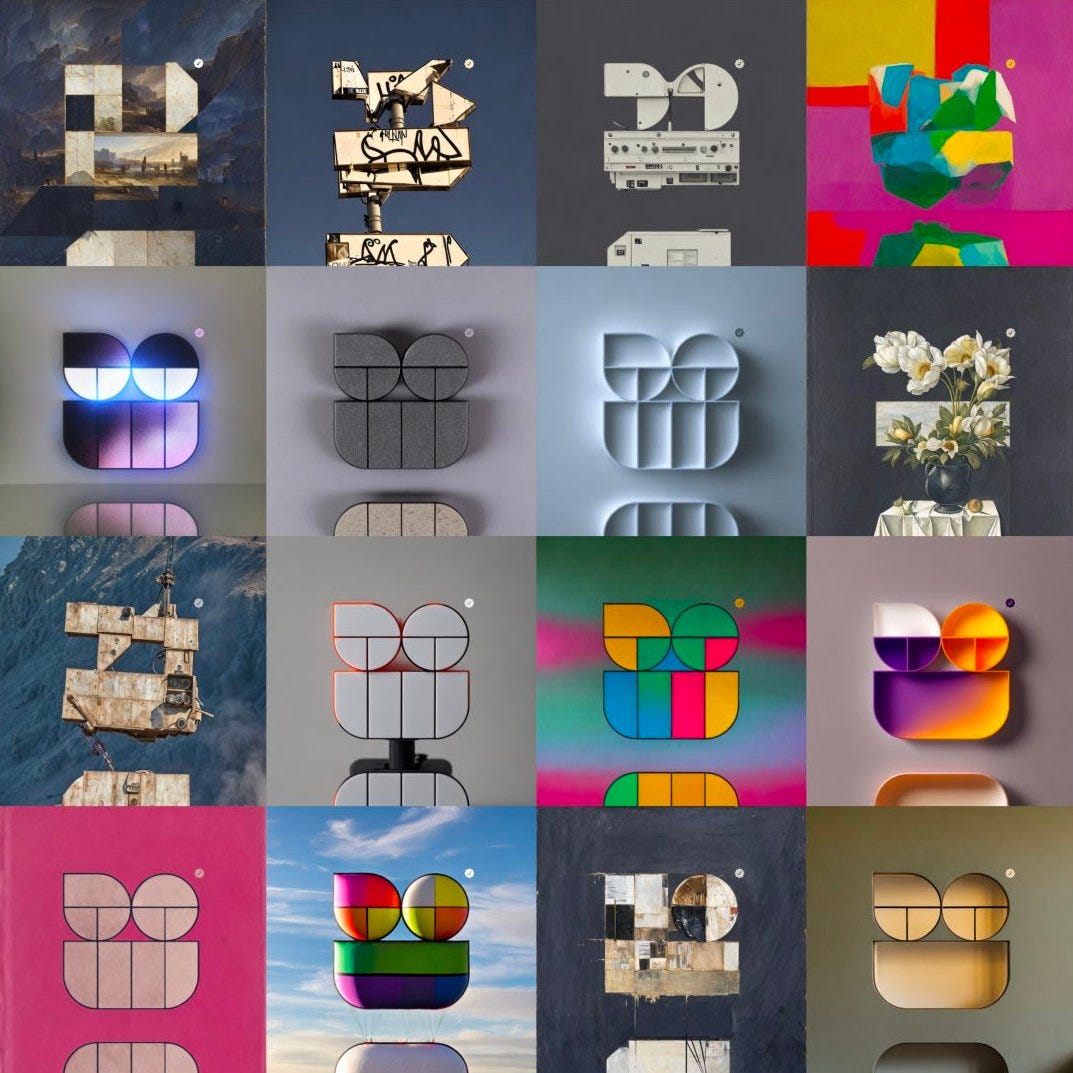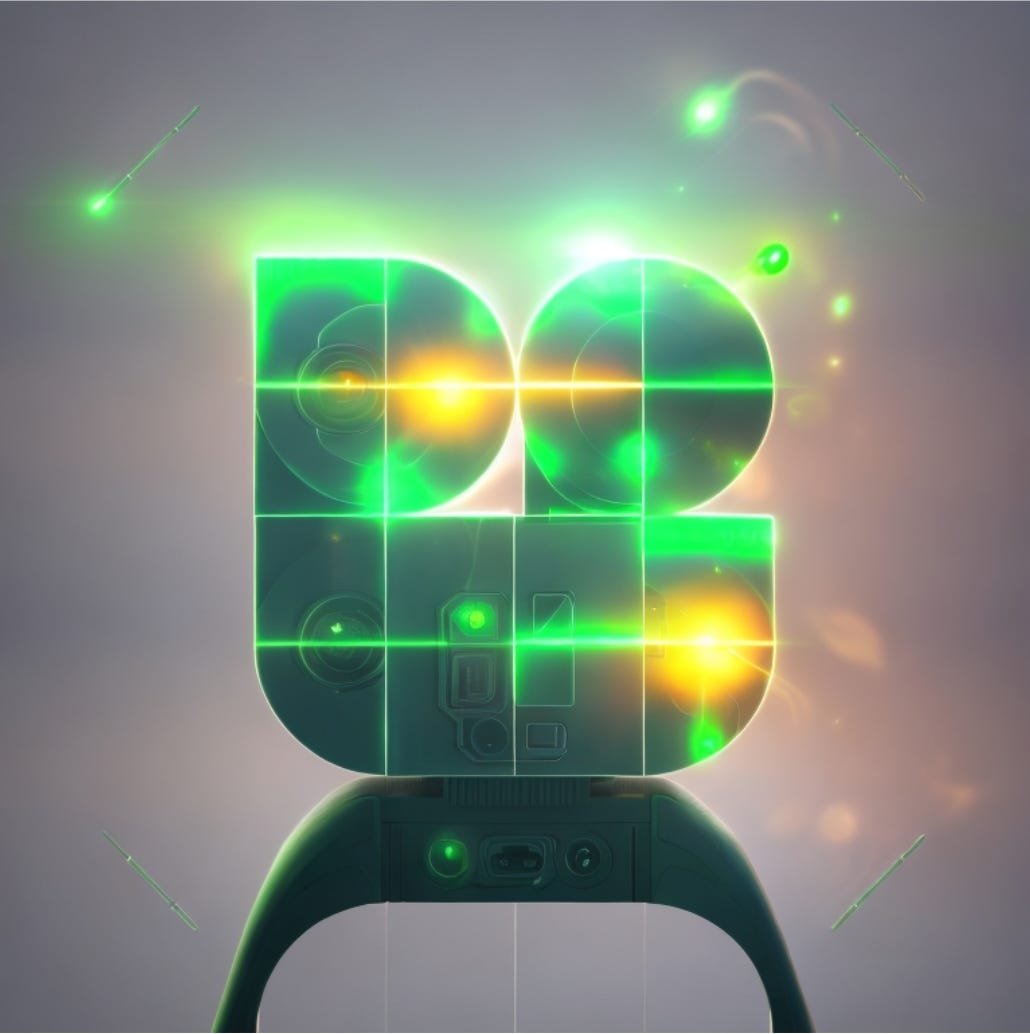GM Readers!
Essay 71 is about the Opepen Art project. It’s another Jack Butcher NFT project that has once again taken the Web3 world by storm. The project highlights commentary on: creation, attention, curation in the world of Web3 x AI.
I see Opepen as a meta protocol that brings its community together.
Hope you enjoy!
P.S. this essay won’t cover the recent Checks Element auction or go too deep into specific mechanisms, more on that at a later date. ✌️
-LJW
Relevant Essay:
🎨 Life in Color Relevant Essays: [Infinite Design Space] + [The Checks Meta] + [AI Rewires Our Work Model]
SHAMELESS Ask:
🙏 Share Life in Color with a friend and ask them to subscribe
🙏 Share on Twitter / Linkedin with a short note
🙏 Share on your company Slack / Teams channels and communities
Seeding the Opepen Meta
Last time when I wrote about Jack Butcher, I covered his Checks NFT project. The essay focused on the dynamics of attention, particularly how attention is our greatest currency.
Check out that essay here 👇
Since then, Butcher and team (big shoutout to Jalil and Traf who are core members of the Opepen team) have been working on an additional project called Opepen — which has once again captured the attention of the Web3 community.
Opepen started as a free mint and very few people thought it was going to become anything more than that.
Then on Feb 19, Butcher tweeted the following:

After the successful run with Checks, Opepen was going to become the PFP (Profile Picture) project that ties it all together.
After all, the NFT community was already used to the idea of PFPs being one of the key use cases for the tech. NFT PFPs check the box on skeuomorphic design (or something that makes the new thing — NFTs — recognizable through the old thing — PFPs). I.e. We’ve had PFPs on social media for a long time.
But then this little thing called (generative) AI took the world by storm.
Rather than fight it and try to put AI back in a box, Butcher and team embraced it.
My personal thesis on AI as it relates to creators / creation: it will drastically lower the cost of production, which means the actual creating is less important than the idea behind the creation.
Pre-AI: The “How” was as important as the “What and Why”. If you had a brilliant idea for a piece of art, but you didn’t know how to draw, it was hard to manifest your idea into the world.
Post-AI: AI handles most of the “How” and the “What and Why” will become increasingly important.
Butcher has always led with the “What and Why.”
While many of the latecomers just see Checks as an NFT … it actually started as an idea / commentary about the state of verification on the Internet.

But if you thought Checks was interesting, Opepen takes it to the next level.
What is Opepen?
Opepen is an NFT project with a collection of 16K NFTs. The base layer is a series of shapes. But on any given day, the metadata for the Opepen NFTs change based on what Butcher and team want to update the NFT image to be — through updating the metadata.
At a high level, Opepen NFTs fall into two categories: revealed vs unrevealed.
Right now the Unrevealed Opepen NFT looks like this.
Revealed NFTs feature the work of different artists where they create art that resembles the base layer Opepen.

The mechanism for how an unrevealed Opepen ends up as a revealed Opepen is based on an Opt In Reveal Mechanism where Opepen holders decide if a set by a particular artist should be released. (See TL;DR tweet on the reveal mechanism … the mechanism design is worth entire essay alone. 😉)
Outside of the Opepen NFTs, the community has also taken the Opepen framework and created their own remixes. (See this tweet for a gif of Opepen images).
The question “What is Opepen” is a deceptively simple question that is actually pretty hard to answer…
… Because it’s made up of a lot of different building blocks that come together.
👇
Opepen Building Blocks
Rather than write one long essay, let’s unpack the individual building blocks with the hope that you, the reader, will form your own opinion on the project.
On Substance vs Form
Substance, in the context of art, refers to the intrinsic value, meaning, and impact of a work. It is the essence of what makes a piece of art unique, and it is often determined by factors such as artistic intent, cultural context, and emotional resonance. You can say, it’s the art itself.
Form, on the other hand, pertains to the physical or digital manifestation of the artwork, including its medium, canvas, style, and presentation.
Traditionally, these concepts have been framed as substance versus form.
Opepen blurs this line.
Butcher has created a canvas / framework / form — the Opepen shapes that make up the Opepen image.
The power of creating the form is that when others reimagine what Opepen is following Butcher’s framework, it adds to the broader collection of Opepen.
A derivative image that anyone creates following the Opepen framework gets instantly recognized by others who have used the same framework.
Butcher is promoting creation that has community inherently baked in. Opepen has made the form a critical part of the final art.
All of the below look different, yet they are all Opepen.

✅
On Remixes and Derivatives
While the NFT community has long advocated for remixing and derivative works, few projects have truly embraced this concept (at scale).
In most cases, the "core" art represented by the NFT is considered the canonical version, with derivatives serving to draw attention to the original.
Opepen, however, has no such "core art," it’s just a framework made up of recognizable shapes.
This encourages remixing and lets the community add layers to the original image. The implicit requirement is that one follows the framework so that it becomes recognizable as Opepen. But since Opepen is a series of base shapes, what is considered Opepen ends up being fairly broad.
Perhaps this is Butcher’s meta point … we are all Opepen.
This approach fosters a sense of community among creators, as they can instantly recognize and connect with others who have used the same framework. By defining constraints while allowing for open-ended creation, Opepen strikes a balance between a completed work and an ongoing conversation, where the bond between creator and community is centered around the (Opepen) framework itself.
This leads to a constantly evolving / community-driven body of work, where no single image is considered the canonical Opepen.
The canonical Opepen is the framework.
✅
On AI, Scarcity and Abundance
We are moving to a world where AI can produce images that use to require a decent amount of resources (people, time, money). AI tools make creation as simple as a few clicks of a button. With generative AI, the skill is describing what you want.
The Opepen meta is supercharged by AI.
All of a sudden a bunch of people on the Internet can participate in Opepen because they can prompt their way to an image.
With the volume of images produced by AI, the concept of scarcity will have to evolve. AI gives everyone the tools of mass creation, but it also raises the bar since we have a finite amount of attention.
Opepen takes a different approach to scarcity — by promoting abundance. It embraces mass creation and lets the the community determine which pieces they consider to be unique and valuable.
Ironically, scarcity can be only be appreciated in a world of abundance.
In the age of AI, it’s not just about collecting (consuming) or creating. It’s also about curating. The concept of scarcity evolves with curation.
The best artist’s will curate conversations, communities and ideas — scarcity is about curation because attention is the scarce thing in this new world.

✅
On Letting the Community Cook
One of the most powerful concepts in Web3 is community.
The Opepen community has reinforced some of the core values behind a strong community. To name a few:
Tools: Some have created tools for other community members to use. For example: Opepefy Art, was created by a community member — you can upload an image and it takes the colors of that image and translates it onto the Opepen Framework.
Education: Opepen community members led tutorials on how to remix images using AI tools — a short masterclass in prompting. What’s amazing is that the AI tool that was used (NounsAI) was built by another Web3 community. NounsAI is a community-built generative AI tool that makes it easy for users to remix images. (Big shout out to Nounsai dot wtf.)
Threads: If you ask about Opepen, often times a community member will have written a thread about it. Once in a while you get an essay as well (like this one 🫡).
All of these community led, bottom up, grassroots efforts reduce the barrier to participate and enable a bunch of people to create.
This is a core value of Web3: don’t just consume, come create. In the past, consuming was the easy part, creating was the hard part.
With AI tools + a clear framework (Opepen Shapes) + a community … creating just became orders of magnitude easier.
Community led creation expands the surface area of this project.
And because it’s open on the Internet… the best Opepen art might not even be created by Butcher, or by any human (alone).
✅
On Meta Protocols
Web3 protocols (like those in L1 / L2 blockchains) define the rules of engagement. In protocol design, it looks something like this:
Protocol: Code that determines how things work + State (history of user data and interactions). I.e. akin to the rules of engagement, frameworks, base layer, infrastructure, etc. in an ecosystem.
Client: Front end / “application” that sits on top and leverages the code and state of the protocol. I.e. akin to the “products” that users interact with.
Having a protocol with defined rules enables interoperability.
Interoperability is often talked about in a technical context — how do different pieces of technology work together under similar standards (e.g. NFTs on Ethereum follow the ERC 721 standard).
But if we pull this up a level, we can view the base Opepen framework as a meta protocol.
Opepen Framework: Base Layer Protocol
Opepen Art: “product” or creation that manifests on top of the “protocol”
The framework is canonical.
The art is evolving.

No single Opepen is the canonical piece that defines Opepen, instead the canonical element across all of the work is how they are related to Opepen.
Think of it this way: each remix and derivative adds another “block” to the “chain of Opepen art.”
They all look different, yet they are all connected.
This is similar to how the best Web3 protocols work — the founding team creates a base layer that the community then adds layers of depth to. And with each additional derivative image, the community brings more attention to the original framework.
The attention generated from all this is community-led and accrues value back to the broader community — bottom up attention with (almost) no marketing needed.
“The best marketing doesn't feel like marketing at all. It feels like a conversation between friends.”
✅
On Philosophy
The philosophy behind this project can be summarized with this Butcher quote: “Design as a process is find an answer to a question, art is trying to ask a question”
✅
So. . . what is Opepen?
It’s a little bit of everything but Butcher and team + community have tied it together into a fairly cohesive thing.
Substance vs Form: The form is as much a part of the art as the substance
Remixing: Give the community a framework to compose on top of
AI: Supercharge creation by embracing AI, change the paradigm of scarcity in a world of abundance
Community Led Creation: Empower bottoms up creation
Meta Protocol: Create an (iconic) interoperable framework that feels like a protocol
Philosophy: It’s an ongoing conversation, in a world that seeks answers, questions become more important.
Perhaps this the simplest answer is: Opepen is art.
Art is about ideas.
In the age of AI and Web3, the ideas of ownership, verification, provenance, community, creation and curation will matter more than ever.

The true essence of art lies in its ability to communicate, inspire, and evoke thinking and emotion.
FWIW, Opepen is doing that for a fledgling community on the Internet.
The idea is greater than the image.
✅ 🔴
🟦🟦🟦🟦
🛟 Disclaimer:
This post is provided for educational and informational purposes only. Nothing written in this post should be taken as financial advice or advice of any kind. The author(s) may own some of the NFTs, art and/or collectibles mentioned in this post. The content of this post are the opinions of the authors and not representative of other parties.
Empower yourself, DYOR (do your own research).








This was my fav essay so far. I hadn't realized the depth of the Opepen project. Thanks for sharing.